INTRODUCTION
The identification of antique bottles is challenging. However, specific determinants can help. According to IPBA, the auction volume of antique perfume bottles will increase by 37% year-on-year in 2023.
Sometimes, people get fooled because they fail to identify the correct antique bottles. This blog explains the signs and symbols that will help you in the correct identification of antique bottles.
This blog explains the importance of antique bottles from the perspective of perfume bottles. It describes how to determine the value of antique perfume bottles. You can also learn about a popular type of antique bottle, the glass Gatorade bottle. It’s going to be an interesting read.
MARKINGS AT THE BOTTOM
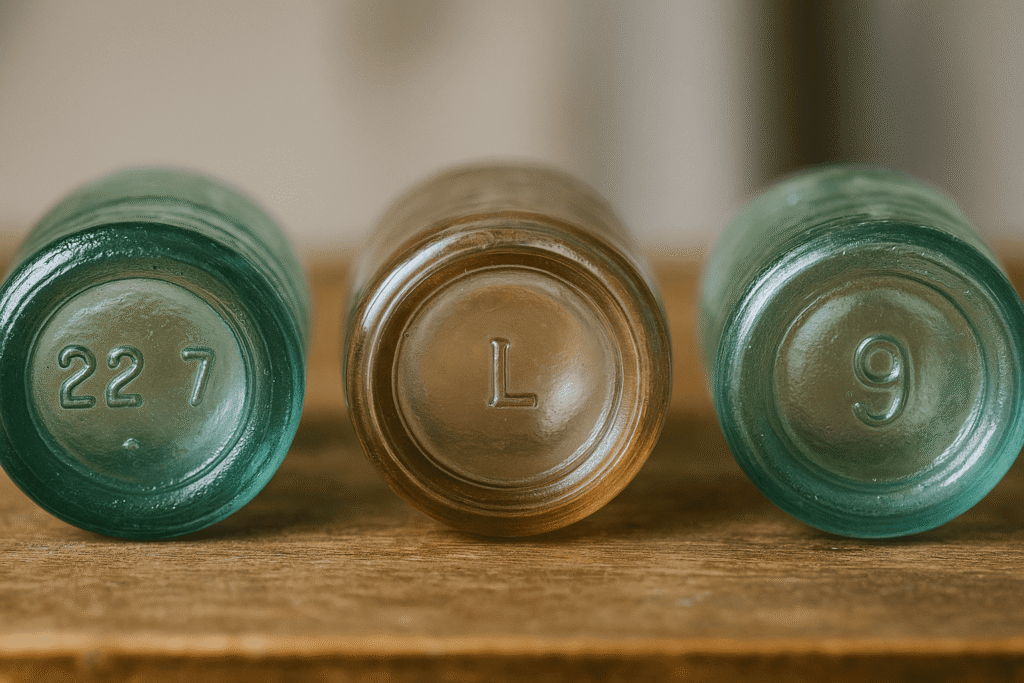
Most of the information about the age of the antique bottle is evident from its base. Bottles have numbers and letters on their bases. These letters and numbers tell how old a glass bottle is. The age of almost all glass bottles ranges between the 19th Century and the modern era.
However, this doesn’t mean that glass bottles didn’t exist before the 19th Century. Before the 19th Century, glass bottles had pontil marks on their bases. These pontil marks, which look like rings and are located at the bottom of the glass bottle, were created by the iron rod used to hold them during manufacturing.
One more thing that the pontil mark shows is that the glass bottles were mouth-blown.
Markings at the bottom of the bottles exist in the form of numbers and letters. You can identify the age of antique bottles by looking at the bottom of it. But how do you know what the numbers and letters mean?
The one—or two-digit numbers at the bottom of bottles indicate the mold number and the section in an automatic bottle manufacturing machine. The markings at the bottom also give ideas of bottle shapes, the manufacturing date, and even the factory’s location.
For example, soda bottles with G- numbers on their bases indicate that Owens-Illinois Glass Company manufactured them.
Maker’s Mark
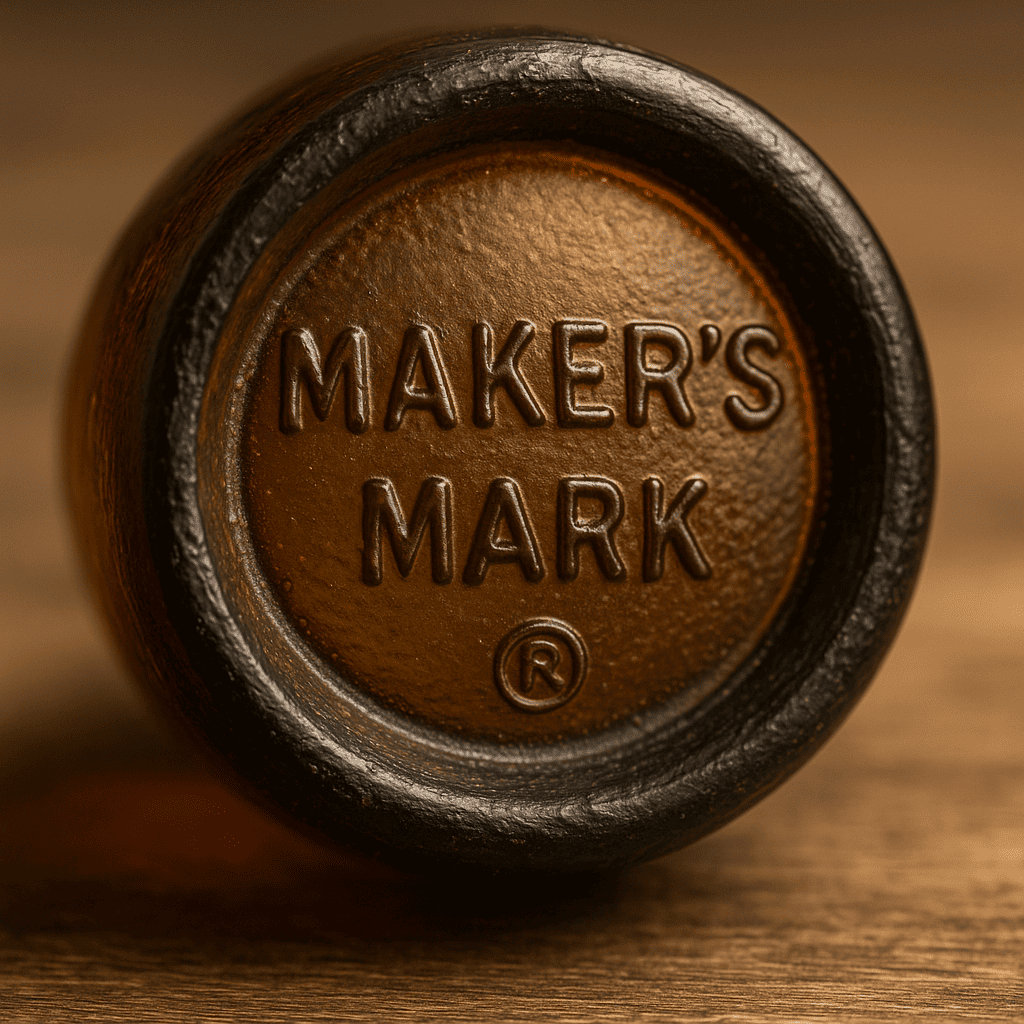
A maker’s mark is a unique way to identify the age of antique glass bottles. It denotes the individual or firm responsible for the production of a particular product. In addition to antique bottles, you can also find it on jewelry, antique canning jars, etc.
Maker’s marks can take the form of brand names, trademarks, and other identifying marks. If the maker is renowned and has left a mark at the base of the bottle, you can easily determine the age of the bottle from the mark. However, the mark has to be well-defined.
SHAPE OF THE MOUTH
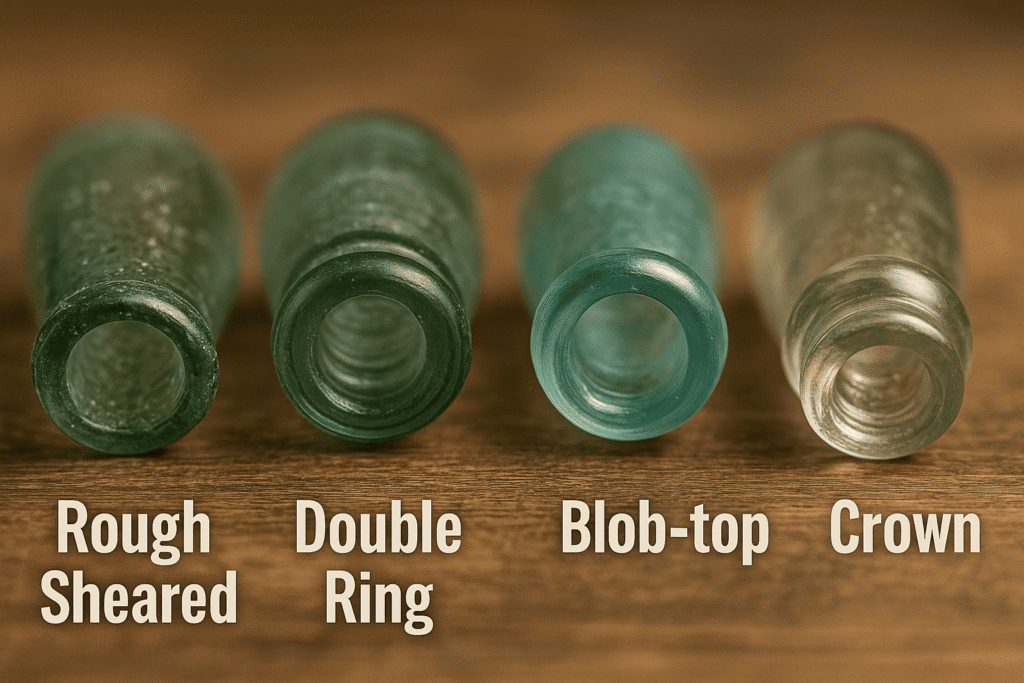
The shape of the mouth is also known as the shape of the bottle’s lip. You should never confuse the shape of a bottle’s mouth with its top. A bottle’s top and mouth are both different. The mouth shape of an antique bottle tells a lot about its age. For example, glass bottles from the 18th Century had rough mouths.
The crude tapered lips of bottles indicate they were manufactured at the start of the 19th Century. As time moved towards the middle of the 19th Century, the mouths of glass bottles became more refined. Double-rounded lips also became popular during this time.
Then came the era of the second half of the nineteenth Century. Antique bottles manufactured during this period have thick blob top lips. These blob-top lips were transitioned into thick donut-like shapes in the later years of the nineteenth Century.
COLOR OF THE ANTIQUE BOTTLE

Who knew that the color of an antique bottle would also become a symbol of its age? Yes, you can determine the age of an antique bottle through its color as well. The age and value of a glass bottle are estimated from its color.
This is because certain antique bottles exist in rare colors, including yellow, teal, and amethyst. Glass bottles of these colors are more valuable than others.
But how is this possible?
This is because different colors of glass were introduced in other eras. The amber-colored glass was introduced in the 19th Century, so if you find an amber-colored antique glass bottle, you know that it was manufactured during that time. The introduction of clear and transparent glass bottles can be traced back to 1662.
EMBOSSED MARKINGS
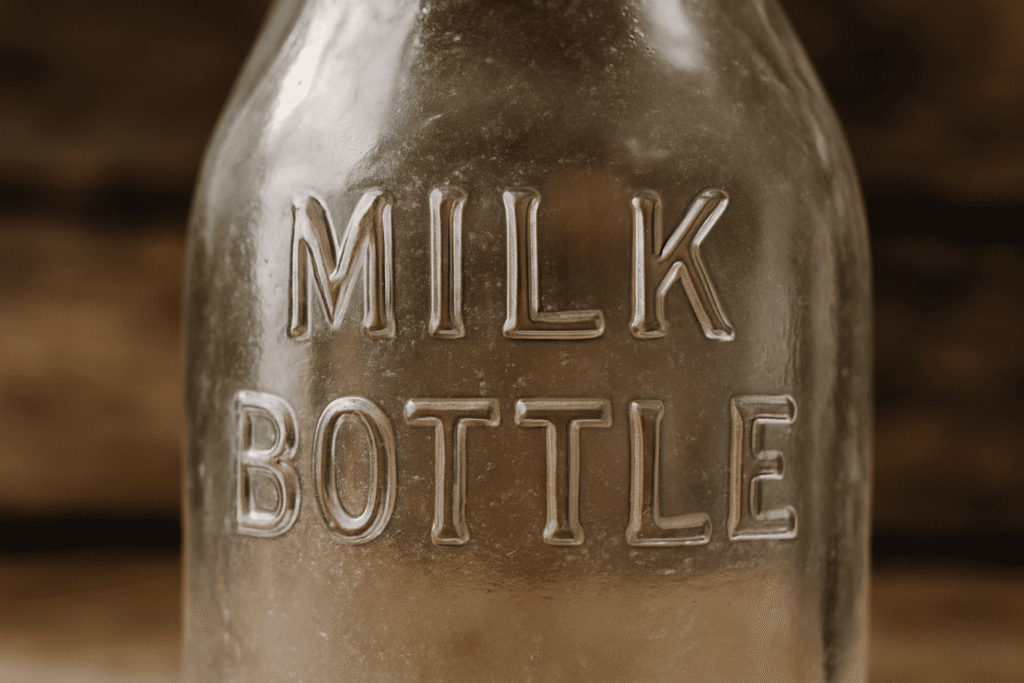
Embossed markings can exist in various forms. They can be in numbers, symbols, letters, manufacturer’s name, date of manufacturing, and even maker’s mark. But how can you determine the age of antique bottles from embossed markings?
You will be amazed that embossed markings are the most convenient way of determining a bottle’s age. Antique bottles mostly have embossed markings on their sides and not on the bottom.
It is because, in old times, carving embossed markings on the bases was not an easy task ( due to design and material constraints). Therefore, half-etched embossed marks were placed on the side of the antique glass bottles’ age.
You can see embossed marks, most commonly in antique Coca-Cola and milk bottles.
VISIBLE SEAMS
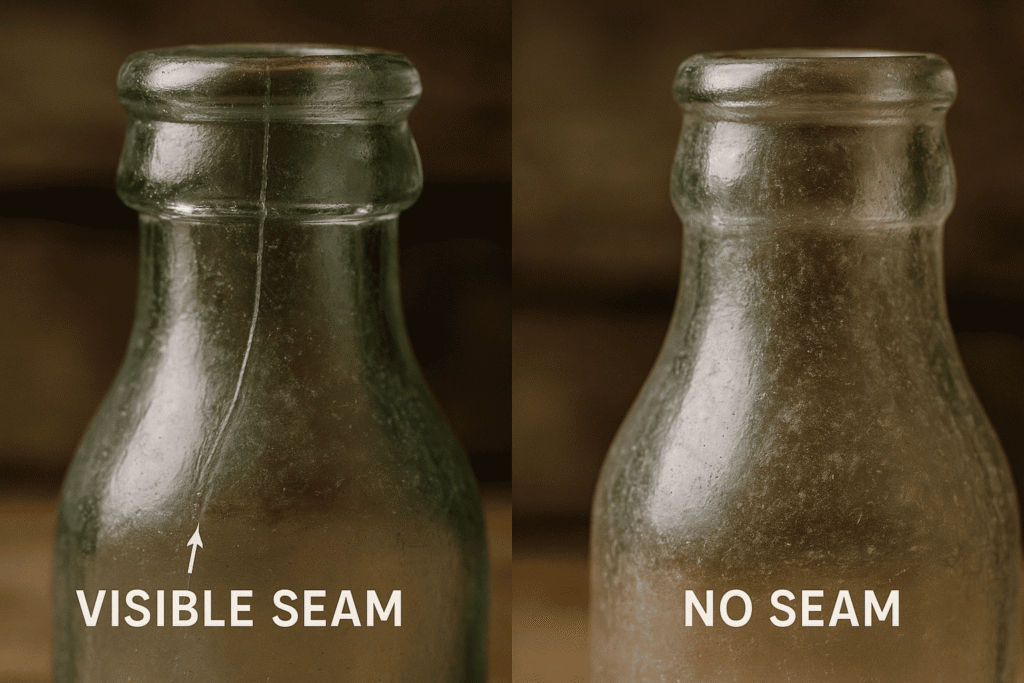
What is a mold seam?
A mold seam is a slightly narrow ridge in the glass object, indicating that it was created using a mold. If you know how glass is made, then you know that during glass bottle production using a mold, the molten glass seeps between the joints of the mold, creating a visible seam.
Although you can make this seamless visible through polishing or grinding, it is never completely removed. Visible seams are evident in antique glass bottles.
Therefore, you can assess the age of antique bottles through visible seams. The height of mold seams indicates the age of antique bottles. Shorter mold seams point towards older bottles.
The length of the seam increased with the passage of time. However, modern bottles do not have any visible seams as they are machine-made.
Thicker and shorter seams are present in the majority of antique bottles manufactured between 1905 and 1920.
SHAPE OF THE TOP
Until now, you must have realized that glass bottles have different tops and shapes. You can identify an antique bottle from the shape and type of its top. There are three different types of tops, i.e.
- Cork top
- Screw top
- Crown top
Cork top
Resembling a stopper, a cork stop has been in use since the Eighteenth Century. It can seal any bottle, irrespective of its shape and size, making it more practical and unique.
However, in the case of carbonated drinks, the operator needs to secure the top. This helps to preserve the carbonation of the beverage. Operators secure the cork by wrapping the mouth of the glass bottle with the help of a plastic wire or cord.
Cork tops are still used today. Many wine brands use cork tops. Cork tops have been a symbol of antique bottles. If you watch old documentaries, you see that the common way of closing glass bottles was using cork tops.
Screw top
The invention of screw tops takes us back to the early eighteenth Century. The popularity of screw tops grew with the manufacturing of machine-made glass bottles. It was in the mid-nineteenth Century.
The use of screw tops is, however, not just limited to antique bottles. Even the modern production methods use screw tops. If you want to identify an antique bottle from its screw top, then look at its lip. Suppose the lip is roughly ground, then it’s an antique bottle.
Crown top
Crown tops were inspired by the Victorian era. They entered the market in the early 1890s and became common among bottle manufacturers in 1915. Their popularity remained unchanged until the introduction of machine-made bottles.
Crown tops are circular in shape and have jagged edges. What makes them different is that you always need a bottle opener to open them. This is the main reason why many beer and soda bottles contain crown tops.
WHAT IS A GLASS GATORADE BOTTLE?
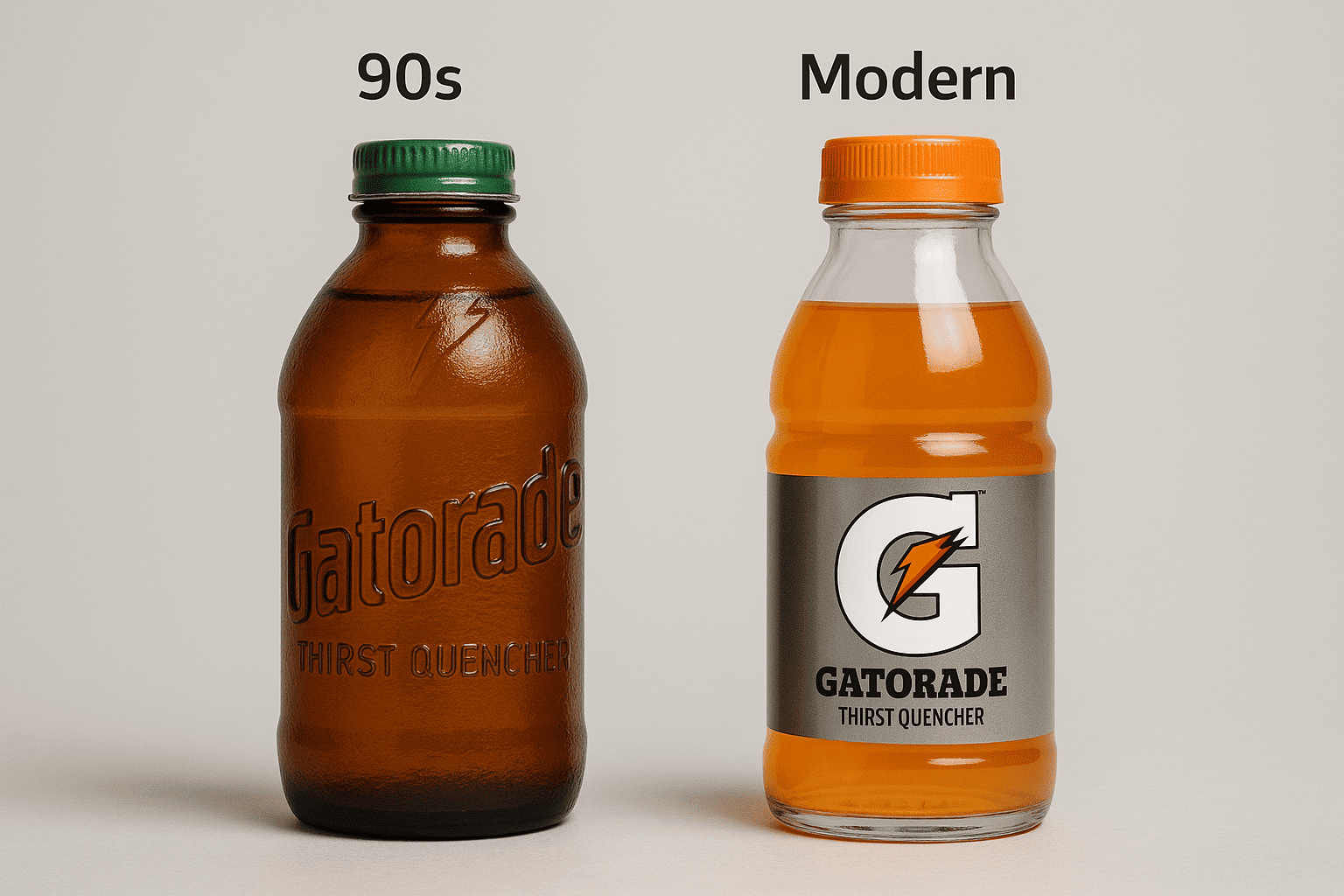
Gatorade is a sports-themed beverage of American origin. It was first made in 1965 by a team from the University of Florida. There is an interesting story behind the bottle’s name.
Since it was a sports-themed beverage, it was initially made for the school’s student-athletes, who were known as gators, hence the name.
The basic purpose behind the creation of Gatorade was to replenish the carbohydrates, water, and electrolytes in athletes that are lost during tough physical activities.
Of course, the bottle was then and even now stored in a glass bottle, the glass Gatorade bottle. Later, in 2001, PepsiCo bought the manufacturing company of Gatorade. Gatorade is sold in 80 countries and is a popular beverage sold and manufactured by PepsiCo.
Now the question is, why are we mentioning glass Gatorade bottles in antique glass bottles?
Many glass bottle enthusiasts who love gathering collectibles are interested in purchasing old Gatorade bottles. This is why old glass Gatorade bottles can be seen for sale on popular platforms such as eBay and Etsy.
Old and vintage glass Gatorade bottles are appreciated by collectors, and people also love to repurpose and upcycle them into vases and other crafty things.
With time, the shape of glass Gatorade bottles has evolved into various shapes. However, collecting old glass Gatorade bottles makes people nostalgic and reminds them of the old flavors that existed during the nineties.
People love collecting old glass Gatorade bottles and talking about them. Therefore, while talking about antique bottles, it is impossible not to mention old glass Gatorade bottles.
DIFFERENCES IN MODLING PROCESSES FOR SPORTS DRINK BOTTLES AND PERFUME BOTTLES
Now that we have mentioned glass gatorade bottles here it is important to discuss the differences in manufacturing of perfume bottles and glass gatorade bottles as well. Glass gatorade bottles represent sports drink bottles. Difference molding processes are used for the manufacturing of both types.
The variations exist in material requirements, product design, and intention to use. Of course the usage of perfume bottles and sports bottles is different. A light weight plastic known as PET is used in making of sports drink bottles mostly.
Perfume bottles are mostly made from glass. Stretch blow molding process is used in the manufacturing of sports drink bottles. Injection molding is the preferred technique in glass perfume bottles. Stretch blow molding supports mass production and uniform wall thickness.
Accurate precision and intricate design customization is the preference in the manufacturing of glass perfume bottles.The manufacturing of glass perfume bottles ends with post manufacturing operations.
These include finishing of the bottles, polishing and decorations. These steps are not necessary in the manufacturing of sports drink bottles such as glass gatorade bottle.
DIFFERENCE BETWEEN ORIGINAL ANTIQUE BOTTLES AND REPLICAS
Perfume and glass bottle enthusiasts love collecting antique bottles, creating a demand for them in the market. Admirers are willing to pay reasonable prices for original antique bottles.
Due to the increasing demand, some manufacturers started producing replicas of antique bottles. These replicas look similar to hand-blown antique bottles in texture and shape, yet they are not antique. The mimicry of antique bottles has been a trend since the 1930s.
If you want to protect yourself from replicas, make sure to carefully read this blog. Identify all the determinants mentioned in this blog to ensure that you are buying an original antique bottle and not a replica.
IMPORTANCE OF ANTIQUE BOTTLES IN THE PERFUME INDUSTRY
Antique bottles hold a special significance in the perfume bottle manufacturing industry. They attract collectors from around the world. Collectors are people looking for beauty, aesthetics, luxury, and glamor of the bygone ages.
For corporations, antique perfume bottles are objects of desire. They value antique perfume bottles because they view them as a symbol of cultural importance and artistry. No doubt, antique perfume bottles are a work of art.
To attract collectors’ attention, antique glass perfume bottles come in a variety of shapes and colors. They also have unique designs and works of art.
For example, they may have ornamental decorations or be painted with hand-made flowers. For an antique perfume bottle to be in good condition, it is important that it be in good condition.
FACTORS AFFECTING THE VALUE OF ANTIQUE PERFUME BOTTLES
As mentioned before, the value of antique perfume bottles depends upon their condition. The better the condition, the more the value. Therefore, in this section, we mention the essential factors that help determine the value of antique perfume bottles.
Historical Importance
Every antique has some historical association. The same is true of antique perfume bottles. Antique bottles that connect with a notable personality or a historical event are considered more valuable.
The Maker
Of course, the value of antique perfume bottles depends on their makers. If the manufacturers of antique bottles were widespread, their value would; its value would be high.
For example, Julien Ward and Lucien Gaillard were important and popular figures in the perfume industry. Once, a perfume bottle designed by Lucien Gaillard in 1928 fetched a price as high as “$27,000 USD (based on Sotheby’s September 2021 Lot #123 sale)” in auction.
Rarity
Rare things are always expensive. So, if a perfume bottle is popular and has limited availability, it must be very valuable.
Artistic Merit
A perfume bottle might be a container, but with the help of complex designs and intricate patterns, it becomes a piece of art. The designs made by popular designers such as Julien Viard and Lucien Gaillard were undoubtedly pieces of art.
Therefore, they were considered to be valuable then and even now. This is what is artistic merit—something that makes an antique bottle unique and valuable.
Record Price
The International Perfume Bottle Association (IPBA) usually auctions antique perfume bottles. During the 2021 auction, the IPBA sold a 1914 Baccarat bottle for 102000 USD.
This indicates the value and demand for antique bottles among collectors and perfume enthusiasts. This is how record prices can indicate the value of antique perfume bottles.
Condition
Although people love having antique perfume bottles, the condition of the bottle is very important. Even if the perfume bottle is antique, it is more valuable if it is present in good condition. If it is damaged and has cracks, then its value will decrease.
MARKINGS SPECIFIC TO PERFUME BOTTLES
There are certain markings that are specific to perfume bottles. These specific markings have both functional and branding purposes. Among these markings are brand logos, volume indicators, recycling symbols etc.
What makes glass unique then plastic is that the specific marlins are more refined and permanent in nature. In this section we shall discuss two markings that are specific to perfume bottles.
Cristal de France Certification Code:
The luxury products manufactured in France have the Cristal de France Certification code. It is a mark of authenticity and quality. Whenever a perfume bottle has the cristel de France Certification code it means that the crystal of the bottle is originally from France.
French crystal is famous for its brilliance, clarity and craftsmanship. Cristal de France symbol is mostly etched on the perfume bottle. It assures the customers that the crystal has all the attributes of original authentic French artisan glassmaking.
Products or perfume bottled with Cristal de France symbol are considered to be collectibles and have high value.
Embossed Signature of the Perfumer:
Perfume created by professional perfumers have usually an embossed signature. This embossed signature is a symbol of personal touch. It highlights the artistry behind the fragrance.
This embossed signature is present on the glass surface. It showcases the creator’s personal endorsement and involvement behind the perfume’s composition.
It is the embossed signature that transforms the perfume from a mere glass container into a prized piece of art. It has both sentimental and historical significance. It creates a link between the fragrance and the perfumer. It reinforces the exclusivity and craftsmanship of the perfume.
CONCLUSION
After reading this blog, we conclude that there is a direct relationship between the age of antique bottles and their value. Antique perfume bottles have always been in demand.
Many essential factors help determine their value. The worth of antique bottles will prevail, and their admirers will exist in the market. Certain perfume bottle manufacturing companies also replicate the designs of antique bottles and combine them with modern fragrances to satisfy the needs of modern antique bottle admirers.

